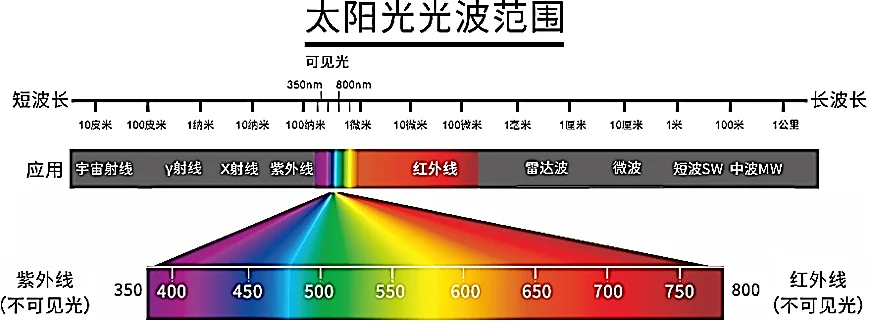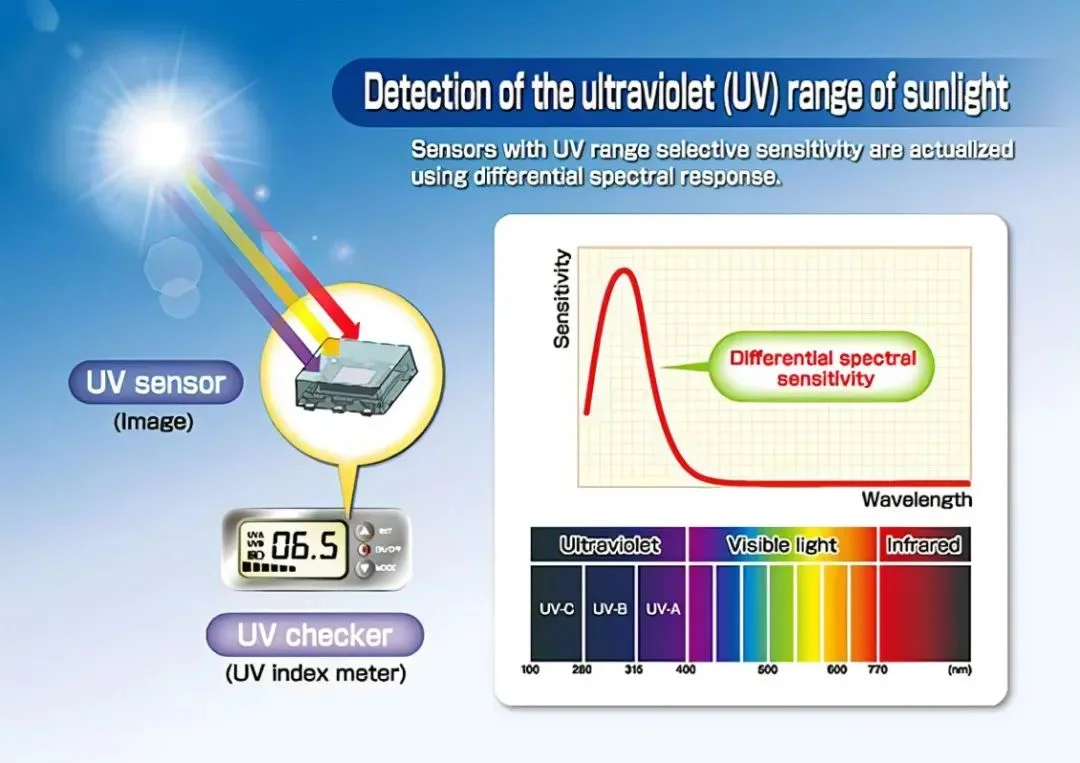- This topic is empty.
-
AuthorPosts
-
2025-09-26 at 10:07 am #7813

Ultraviolet light refers to light with a wavelength of less than 400 nm, accounting for 7% of solar radiation. High-intensity ultraviolet light less than 300 nm is harmful to plants, and ultraviolet light less than 280 nm can kill plants. 320-340 nm has a small effect on plant cryptochromes . Sunlight is a continuous spectrum, with a wavelength range from 100 nm X-rays to 100 m radio waves.
99% of the energy in solar radiation is concentrated in the 280-500nm band. The spectrum with a wavelength greater than 760m is called infrared light. The heat on the earth's surface basically comes from the solar infrared radiation energy. Different spectra in sunlight contribute differently to plant photosynthesis. Only the light in the 400-700m range is photosynthetically active radiation for plants and participates in the light reaction process of carbohydrate synthesis in plants.
According to the perception of human eyes, the solar spectrum is usually divided into visible light and invisible light. The wavelength of visible light is 380-760nm, which is further divided into red light (625-760), orange light (595-626), yellow light (575-595), green light (470-575), blue light (435-470) and violet light (380-450). Invisible light includes infrared light and ultraviolet light, among which the wavelength less than 380nm is called ultraviolet light. According to the physical and biological characteristics of ultraviolet light, it is divided into three bands: long-wave ultraviolet light (UV-A) with a wavelength of 320-380nm, medium-wave ultraviolet light (UV-B) with a wavelength of 280-320m and short-wave ultraviolet light (UV-C) with a wavelength of 100-280mm.

Visible light accounts for about 50% of all solar radiation, infrared accounts for 48% to 49%, and the remaining ultraviolet light accounts for 1% to 2%. Studies have shown that photosynthetically active radiation, UV and far-infrared light in the sunlight spectrum have regulatory functions on plant growth and development, and have application value and regulatory necessity in agricultural production.
The UV and photosynthetically active radiation in the plastic greenhouse are greatly reduced due to the shielding effect of the greenhouse film, while the UV and photosynthetically active radiation in the glass greenhouse are reduced by as much as 66% and 45%, and the maximum loss rate occurs at 12:00, and the loss rate increases with the increase of sunlight intensity. Therefore, under the facility conditions, the light intensity obtained by plants increases with the increase of sunlight intensity, and the inflection point is 12:00.

UV radiation reduces plant leaf area, inhibits hypocotyl elongation, reduces photosynthesis and productivity, and makes plants susceptible to pathogen attack, but can induce xanthophyll synthesis and defense mechanisms and promote anthocyanin synthesis. UV-B exposure leads to dwarf plant phenotypes, small and thick leaves, short petioles, increased axillary branches, and root-to-crown ratio.
A study of 16 rice cultivars from seven countries grown in greenhouses showed that the addition of UV-B caused an increase in total biomass in four cultivars and a decrease in 12 cultivars; leaf area and fraction of those cultivars sensitive to UVB were significantly reduced; chlorophyll content increased in six cultivars (of which two reached significant levels); leaf photosynthetic rate was significantly reduced in five cultivars, and significantly increased in one cultivar (whose total biomass also increased significantly) ( Teramura et al., 1991).
The UV-B/PAR ratio is an important determinant of plant response to UV-B. For example, UVB and PAR jointly affect the morphology and oil yield of mint, and the production of high-quality oil requires high levels of unfiltered natural light ( Behn et al., 2010).
Leaves absorb 90% of incident UV-B. Leaves contain water-soluble phenolic pigments, flavonoids, which strongly absorb UV-B but not PAR. Therefore, in many plant leaves, very little UV-B can be transmitted to the point where it can damage the photosynthetic apparatus. After greenhouse-grown peas were exposed to UV-B (280-315nm) for 4 to 5 hours, the net photosynthetic rate was significantly reduced, while the leaf mesophyll resistance to CO2 diffusion and dark respiration were significantly increased. After 9 days of UV-B exposure, the dry weight of the plants was significantly lower than that of the control plants ( Brandle et al., 1977). UV-B can reduce the concentration of ascorbic acid and B-carotene, but can effectively promote anthocyanin synthesis . UV-B exposure leads to dwarf plant phenotypes, small and thick leaves with short petioles, increased axillary branches, and changes in the root-crown ratio. UV-B adaptation also affects the relationship between plants and herbivores. Therefore, UV-B is a regulatory factor that controls the relationship between plants and their biotic and abiotic environments.

The ratio of UV-B/PAR is an important determinant of the plant's response to UV-B. For example, UV-B and PAR interact to affect the morphology and oil yield of mint ( Mentha x piperita ), and therefore, high levels of unfiltered natural light are required for the production of high-quality oil ( Behn et al., 2010). Under field conditions, supplemental ultraviolet radiation (UV-B, 300m, 3.0 or 5.1 kJ/m2) reduced the yield of soybean cultivar Essex by 20%, but there was no significant change in seed protein and lipid content ( Teramura et al., 1990). The results of a greenhouse study of 16 rice varieties from seven different regions, including China, India, the Philippines, Nepal, Thailand, Vietnam and Sri Lanka, showed that the addition of UV-B led to an increase in total biomass in four varieties (of which only one, from Sri Lanka, reached a significant level), and a decrease in 12 varieties (of which six reached a significant level); the leaf area and score of the UV-B-sensitive varieties were significantly reduced; the chlorophyll content was increased in six varieties (of which two reached a significant level); the leaf photosynthetic rate was significantly reduced in five varieties, while it was significantly increased in one variety (whose total biomass also increased significantly) ( Teramura et al., 1991).
Although laboratory studies of the effects of UV-B have been effective in identifying transcription factors and other molecular and physiological factors, they are usually not mechanically extrapolated to actual natural environments due to the use of higher UV-B levels, the absence of concomitant UV-A, and often very low background PAR. Field studies usually use UV lamps to increase or filters to reduce UV-B levels.
UV has application value in facility horticulture, and UV-LED has begun to be applied in practice, which is valuable in regulating plant color and regulating the synthesis and accumulation of secondary metabolites. However, the application of UV in facility horticulture should follow the principle of short-term, small amount and multiple times to avoid plant damage.
https://www.y-crystaled.net/ultraviolet-uv-plant-photobiology.html
http://www.y-crystaled.net
Shenzhen Yuanjing Optoelectronics Technology Co., Ltd. -
AuthorPosts
- You must be logged in to reply to this topic.
